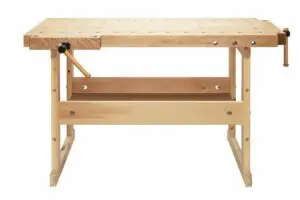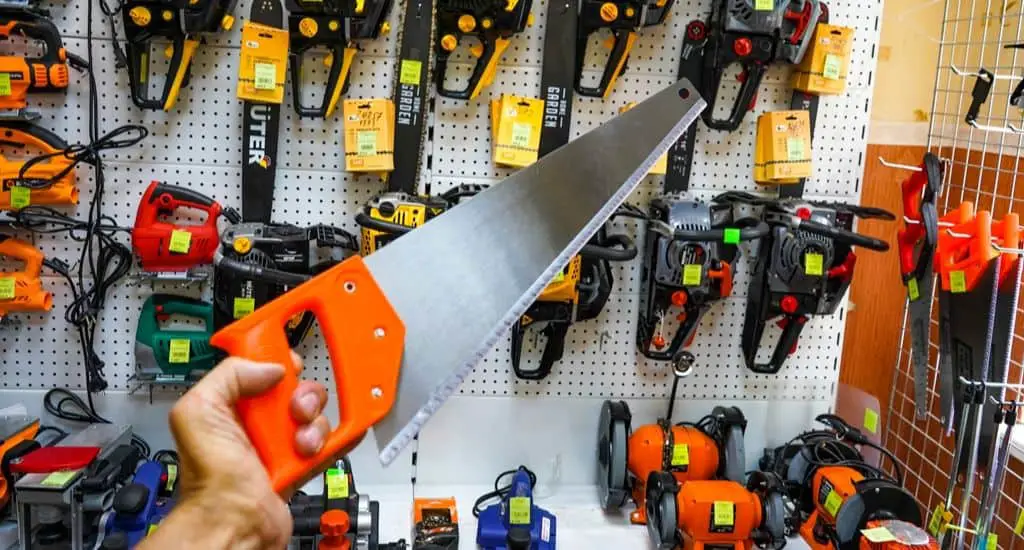
A woodworker who works with their hands relies on a number of tools saws to help them get the job done.
Choosing the right tool saws for the job can help it get done in the quickest amount of time. This will ensure a happy customer and more time to do more work.
However, there are a lot of different tools saws to choose from. In order to help you choose wisely, here are 50 different types of saws and their uses (include hand saws and power saws).
Knowing the difference can help you make the right selection for your job or when purchasing your next saw.
Table of Contents
- Different Types of Hand Saws
- 1. Coping Saw
- 2. Back Saw
- 3. Fret Saw
- 4. Folding Saw
- 5. Rip Cut Saw
- 6. Hacksaw
- 7. Pruning Saw
- 8. Crosscut Saw
- 9. Bow Saw
- 10. Wire Saw
- 11. Bone Saw
- 12. Keyhole Saw
- 13. Compass Saw
- 14. Razor Saw
- 15. Japanese Saw
- 16. Veneer Saw
- 17. Carcass Saw
- 18. Wallboard Saw
- 19. Camping Saw/Backpacking Saw
- 20. Manual Pole Saw
- 21. Frame Saw
- 22. Pocket Chainsaw
- Different Types Of Power Saws
- 1. Table Saw
- 2. Miter Saw
- 3. Circular Saw
- 4. Reciprocating Saw
- 5. Scroll Saw
- 6. Rotary Saw
- 7. Chainsaw
- 8. Pole Saw
- 9. Chop Saw
- 10. Flooring Saw
- 11. Jigsaw
- 12. Track Saw
- 13. Compound Miter Saw
- 14. Masonry Saw
- 15. Band Saw (Stationary)
- 16. Band Saw (Portable)
- 17. Radial Arm Saw
- 18. Tile Saw
- 19. Oscillating Saw
- 20. Panel Saw
- 21. Concrete Saw
- 22. Alligator Saw
- 23. Chain Beam Saw
- 24. Cold Saw
- 25. Jamb Saw
- 26. Straight Flush Saw
- 27. Sabre Saw
- 28. Toe-kick Saw
Different Types of Hand Saws
Hand saws are saws that workers use manually. They need to use their own strength to cut something. There is no electricity of power involved.
It offers the personal human touch many people like, but it won’t offer as much power as some other options. Here are 22 types of handsaws.
1. Coping Saw

A coping saw is a bone saw with a D-shaped frame and a thin blade with fine teeth. The saw is very flexible and strong. You can cut through both wood and soft metal.
It gives you the opportunity to exchange the blade easily, making it a great saw for a large range of projects. It is often used to cut moldings and coped joints. It can even be used to etch details into materials.
2. Back Saw

A backsaw is a handsaw with a reinforced short, narrow blade. It provides a thin, straight cut. It also has a reinforced backing on the opposite end of the blade to help the user make the best cut.
It is often used in making cabinets. A backsaw is called so because it is reinforced on the back, providing extra leverage.
3. Fret Saw

The fret saw is a bow saw with an extremely long C-shape to it, making it great for making deep and intricate cuts. It is the choice over a coping saw when the cut is complicated. It has extra-fine teeth and up to 32 teeth per inch.
The long frame with the short blade makes it look a little unusual; it definitely stands out. It cannot rotate, though.
4. Folding Saw

A folding saw is a saw with a blade with one side of the teeth. It has the ability to fold into itself for easy transportation, similar to a Swiss army knife. It’s extremely small.
You may be able to carry it in your pocket. Use it to help survive in the woods in the case of an emergency. It’s also very useful during camping to help create shelter or cut through rope and bone.
5. Rip Cut Saw

The rip cut saw is the most common saw available. It will sometimes be referred to in general terms as simply a “hand saw”. It’s used for a lot of framing jobs. The teeth on the blade are particularly sharp.
The saw comes in a wide variety of sizes for a wide variety of needs. It is a staple in every tool box because of how often contractors need to use it.
6. Hacksaw

A hacksaw uses a C frame to provide support. There are up to 32 teeth in the blade. Use a hacksaw for just about anything, including wood, plastic, and metal. Aluminum, however, can be problematic. If you do cut aluminum, be sure to clean it properly to avoid material gumming up on the teeth.
7. Pruning Saw

Pruning saws have a curved blade up to 13-15″ long. The blade is specifically designed to cut small branches. The length allows landscapers and arborists a good reach.
The curve helps them wrap around the plant they are trimming. They have a handle similar to that of a gun, making it easy for many people to handle.
8. Crosscut Saw

The crosscut saw is a long, proliferated handsaw. The blade isn’t especially thick. It can even be so thin that it seems to bend at times. This means it’s not great for precise cuts since it may wobble while you cut. It doesn’t have the reinforcement of other saws.
It is used mostly for cutting wood or logs against the grain with its crosscut teeth. This should not be used for projects where you need to cut the wood with the grain.
9. Bow Saw

The bow saw is named for its resemblance of a bow. The bow-like frame keeps the blade especially firm. The blade won’t wobble or move at all while you cut.
You’ll want to use a bow saw for outdoor cutting. You can achieve both straight and curved cuts with a bow saw. Use it for trimming trees and cutting logs.
10. Wire Saw

Most people assume that all saws use blades to cut things. However, that’s not the case. A wire saw actually uses a wire to make its incisions.
They come in both hand saws and powered versions. Many people use it to cut branches. The wire rubs against the branch until its worn away.
11. Bone Saw

Bone saw rarely used for DIY projects. You can use it with the cooking, it is useful to cut through bones make great food. Even doctors use saws. Bone saws are used specifically to help doctors in surgery.
They can be used to remove broken bones and cut bones during surgery. They are generally very small. It comes in unpowered, reciprocating, and sonic versions.
12. Keyhole Saw
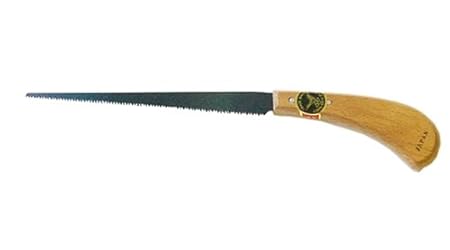
The keyhole saw is long and comes down to a narrow point at the end that might even be able to fit into a keyhole. You can use to cut circles, curves, frets and holes into drywall.
It also has a convenient rounded handle for easy gripping. It’s rather lightweight, making it easy for people who need to transport it. The Keyhole saw also called with other names as pad saw, drywall saw, jab saw and alligator saw.
13. Compass Saw

A compass saw has a long, thin blade. Like a keyhole saw, it gets more narrow at the tip. It’s designed to make twisted incisions.
Compass saws are specifically made to reach places that other saws can’t possibly reach.
It is another saw with a pistol-like handle that many people prefer. It can cut through wood, plastic, and drywall. Its pointed blade eliminates the need for a pilot hole in various types of work.
14. Razor Saw

Instead of having a blade with jagged teeth, the razor saw uses a fine razor blade. This offers a very clean cut. This also prevents it from ripping up softwood, but it’s also used to cut soft plastic and other soft materials.
It comes in a variety of different sizes. These are great for hobbyists. They can help jewelers or people who make model planes get the exact cut they need.
15. Japanese Saw

The Japanese saw uses on thin but strong blade. As the name suggests, the Japanese saw was made popular by Japan. It was primarily used for carpentry and other woodwork.
It is unique since it makes its cut on the pull stroke as opposed to the push stroke-like most other saws. It’s important to know this to utilize it correctly. It’s a rather simple but effective design. It is still used in many areas of the world.
16. Veneer Saw

Veneer work requires a precise cut. For that reason, the veneer saw has about 13 teeth per inch. It has a double-sided blade as well.
This gives it a very unique look compared to other saws. The offset handle helps do work in previously awkward angles.
17. Carcass Saw

Carcass saws have a large, thick blade with a lot of sharp teeth per inch. The one sides blade is enforced. It’s used for cut tenon shoulders, across the grain and defining edges of a dado.
It also cut quickly, smooth crosscut and precise with 14 points per inch. This saw is great cross-cut pattern saw.
18. Wallboard Saw

It looks seem similar to keyhole saw. The wallboard is a double-edge saw with a low number of teeth per inch and a short blade.
Many use it when working with drywall. It can puncture through the drywall if necessary or create a starter hole for larger tools.
19. Camping Saw/Backpacking Saw

While on intense camping trips, a hand saw can come in handy. That’s why people created the useful camping/backpacking saw. It is obviously portable for easy carrying while hiking.
It is smaller than most other saws, limiting its uses to some degree. Camping saw is used to get firewood or prune a pesky tree in your camp yard.
20. Manual Pole Saw

The manual pole saw is a great type of saw to use to reach for higher places or to reach for places that are simply not accessible by hand.
This type of saw will give you a good workout while also allowing you cutting and pruning branches from light to medium that is far away.
While many people prefer electric or gas pole saws, a manual pole saw will give you a bit more control.
21. Frame Saw
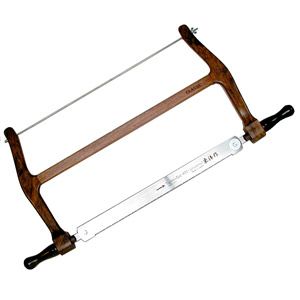
A frame saw is a relatively old-school piece of equipment, but it can serve you very well even today. The frame on the saw provides you the stability you need in order to cut through wood.
These are made primarily for cutting wood, although you can also buy blades that are made for cutting metal. You can even create a frame saw yourself if you want.
22. Pocket Chainsaw
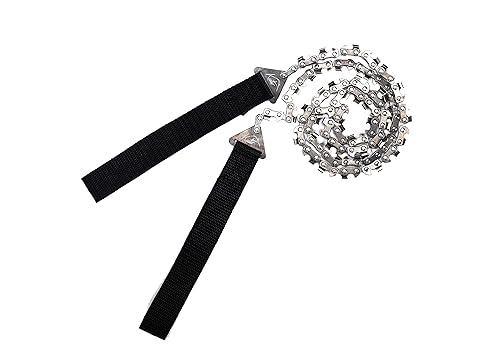
If you’re an outdoor type of person, then a pocket chainsaw can serve you very well. The best thing about it is that you can easily create one yourself.
You can take the chainsaw from an old piece of machinery, split it at one point, and add handles to each side of the chain.
That way, you have a good pocket chainsaw that you can use on the go. It’s great for cutting through the wood when you’re traveling or when you’re outside.
Different Types Of Power Saws
Power saws are a type of saw that work with the help of electricity or battery. It makes them as powerful tools with much less strenuous to use than handsaws. It gives them the opportunity to do more as well. Here are 28 types of power saws.
1. Table Saw

This saw is great for large jobs. A circular saw stays in place on a table. As the blade is powered, a worker will push the wood through the blade.
The table gives the operator the leverage required to make precise cuts. It’s not ideal for cutting metal.
It’s also not portable, so you need to work in one place. The table saw is also one of the most dangerous tools since the operator’s fingers need to get so close to the blade. Be extraordinarily careful when using this tool.
Take your time and pat close attention to your finger placement at all times. You should also turn the saw off when it is not in use.
See also: Different Types Of Table Saws
2. Miter Saw

The miter saw is specialized to make a very specific type of cut- miter cut. This is a cut that helps to create a corner, usually at 45 or 90 degrees. A powered miter saw has a circular blade up to 12 inches. A worker will move the blade onto the item they want to cut.
It is known for the ability to create cuts at about any angle. It can cut just about any material. Most workers will get more use out of a regular table saw, so it’s important to consider how often you will need the miter saw.
There are many similarities between the miter saw and table saw, both use rotation blade movements, one is compact but other one is more stable and has wider working area.
Also, there are some minor things that a milter saw can do but table saw can’t.
See also: DeWalt DWS779 Vs DWS780 Miter Saw
3. Circular Saw

As the name suggests, the circular saw uses a circular blade up to 9 inches in diameter Opposite of the table saw, the operator takes the blade and pushes it against the item they want to cut.
They are often used in a number of different industries, used to cut wood, plastic, metal and more.
Since it is operated by a laborer, manufacturers offer both a left-handed and right-handed option to help people be as comfortable and safe as possible. It’s portable, making it is convenient tool for someone who needs to travel to different job locations.
It’s also relatively small, making it easy to store. You will not necessarily be able to make the most precise cuts with this tool.
See also:
- Miter Saw Vs Circular Saw – Which One Is Better?
- Corded Vs Cordless Circular Saw – Which One Is Right For You?
4. Reciprocating Saw

The reciprocating saw is a handheld saw with a blade that moves back and forth. It used to cut wood, plastic, and tubing. Also, this is the main tool used for demolition remodeling since it can cut through just about anything.
You can get a corded reciprocating saw or a cordless one. If you opt for the cordless version, always charge the saw before you leave for the job site. You can also find a mini version for jobs that are a little more detailed.
5. Scroll Saw

The scroll saw is an extremely accurate stationary saw with an extremely fine blade. The blade moves in a back and forth motion as opposed to continuous motion. Like coping saw, this saw is designed for spiral lines and intricate scroll work.
The saw is often used in woodworking. It is known for being able to make awkward curved cuts. They are a relatively safe saw, making them a nice option for people just starting out.
See also:
- Scroll Saw vs Band Saw – Which Is Better For You?
- 73 Free Scroll Saw Patterns For Beginners And Advanced Woodworkers
6. Rotary Saw

A rotary saw is a rotating power saw made to put holes into drywall and similar material. It usually only has one handle.
This saw is effective if you want to cut into the wall without pilot holes. Also, like the keyhole saw, it is necessary for paneling, drywall, and other small cutting tasks.
7. Chainsaw

A chainsaw uses a chain to allow the saw to rotate. They are especially helpful when cutting down trees and large branches.
Chainsaws have a lot of options on the market from brands and models.
The most gas chainsaws are more powerful used in woodworking when compared to other options as electric and battery chainsaws.
See also: Why Were Chainsaws Invented?
8. Pole Saw

If you need some extra reach for your saw, the pole saw is the perfect saw for you. It can extend up to 16 feet long or more. At the end, you have a sharp blade used to cut the desired item.
This reach makes it great for reaching high tree branches or deep bushes. You will have plenty of control since the reach allows you to stand firmly on the ground. It’s used with the power source as gas engine or electric or battery.
9. Chop Saw

A chop saw is a type of specialized circular saw. It is used to make straight cuts, making it good for square and rectangular cuts. It is faster to use than a typical circular saw.
It is often used as a replacement for a number of different saws. It’s designed to cut through the toughest materials, such as metal and masonry. They can cut angles but not as well as a miter saw.
See also: Chop Saw vs Miter Saw – Which One To Choose?
10. Flooring Saw

This saw is designed to handle any cuts related to flooring materials as hardwood, bamboo, engineered, or laminate. It is portable, allowing the worker to bring it to wherever the flooring material happens to be. Any contractor will need to use this regularly.
11. Jigsaw

A jigsaw is a handheld powered saw. It has a smaller blade and finer teeth than a reciprocating saw. It moves vertically. You can change the speed to make it go faster or slower. This saw is designed to cut curves and other non-straight lines.
See also:
- Reciprocating Saw vs Jigsaw – Which Is Better For You?
- Best Cordless Jigsaws – Reviews & Buying Guide
12. Track Saw

Track saws are rather similar to table saws and circular saws. However, they make the same long, precise cuts without requiring clamps or other additional materials. Many options are also portable, allowing you to take them wherever you need to go.
13. Compound Miter Saw
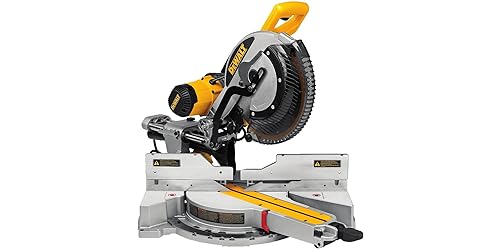
Compound miter saws have all of the benefits of miter saws plus a few more. This is a miter saw on steroids. They make all types of cuts. The blade is attached to an arm for stability and precision, allowing it to make detailed cuts.
See also: DEWALT DWS709 Vs DWS779 Miter Saw
14. Masonry Saw

A masonry saw is very similar to a concrete saw. The masonry saw is specifically designed to work on large building materials, such as concrete, brick, and asphalt. It is large enough to tackle the largest pieces of materials. It can be somewhat impractical to transport at times because of its size.
15. Band Saw (Stationary)

This tall machine sits stationary on the ground. It has a large table with the saw attached. Large mechanisms on each side of the table cut through just about any material. It’s main downfall is that it can only cut a couple of inches deep. All band saws use abrasion to make their incisions.
See also: Band Saw vs Table Saw – Which One to Choose?
16. Band Saw (Portable)

Similar to the stationary option, the portable band saw gives the worker the opportunity to work from just about anywhere. You can take it to a different factory, your garage, or outdoor job sites. It can only cut up to 4″ diameter pipes. Great for plumbers and welders.
17. Radial Arm Saw

A radial arm saw consists of a circular saw placed on a horizontal arm. The arm slides, allowing it to cut the desired material. It has the capability to do intricate cuts.
The radial arm saw was used often until the introduction of the miter saw. The main reason for this is safety. Plus, it became easier to do the angled cuts.
18. Tile Saw

A tile saw is primarily used to cut tile and other building materials, such as ceramic, porcelain, and stone. It’s known for leaving a smooth edge. It is stationary, so you’ll have to cut your building materials and then bring them to the job site.
Many people use the wet tile saw to process where they wet the materials and the blade before cutting to prohibit any damage to the blade or the materials.
19. Oscillating Saw

An oscillating saw generally comes in the form of a multi-faceted multi-tool. It always includes the small oscillating saw. Like an oscillating fan, the saw is powered to move back and forth.
It generally also comes with tools for sanding and polishing. It can be used to trim pipes and wood among a variety of other tasks.
20. Panel Saw

The panel saw is a saw designed to make specific shapes. It is the first saw that offered edging. This saw are used in sign making, cabinetmaking and similar industries.
Since the edges didn’t need to be fed through the saw manually, it provided a more efficient option to get the job done.
21. Concrete Saw

The concrete saw is one of the most heavy-duty saws available. As the name suggests, it can indeed be used to cut through concrete and other ridiculously hard materials.
It is often used in road work. They range in size from small handheld options to large walking saws. These saws can produce a lot of dust, so be prepared.
22. Alligator Saw
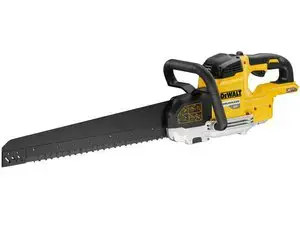
When you’re cutting through tougher pieces of materials such as timber, hollow clay blocks, or aerated concrete, then an alligator saw can make you create straight cuts.
It has two durable saw blades that move in opposite directions. This composition allows you to make accurate and straight cuts through even the toughest types of surfaces.
23. Chain Beam Saw

Chain beam saws can be quite expensive. But they will save timber framers and log builders a lot of time.
That’s why they’re a highly valuable piece of equipment, as they will save a lot of time and cut the amount of work you need to do.
At the same time, they look a bit like a circular saw combination with a downward chainsaw that you can hold in your hands, although this piece of equipment is quite unique.
24. Cold Saw

Cold saws have an interesting name. This name comes from the fact that these saws will stay cold even after a prolonged period of use.
That’s mainly thanks to the materials they’re made from. They are used by sheet roofers, specifically in cutting metal.
25. Jamb Saw

Jamb saws are not used that regularly, although they’re pretty handy for flooring means.
It’s a type of equipment that you’ll want to rent rather than own, although you need to have it if you’re someone who does flooring a lot.
It will help you create cuts where the door jamb is so you can lay the flooring flush with the wall, so you can easily place the flooring without jamb or molding.
26. Straight Flush Saw

A straight flush saw is a handheld piece of equipment that’s used to create straight cuts alongside posts, studs, headers, and more.
This type of equipment is relatively new, although it’s quite popular so it will counter the regular, classic saw.
Perhaps the best thing about this saw is its portability. You can hold it in your hands and take it anywhere with you, meaning it’s easy and simple to use.
27. Sabre Saw
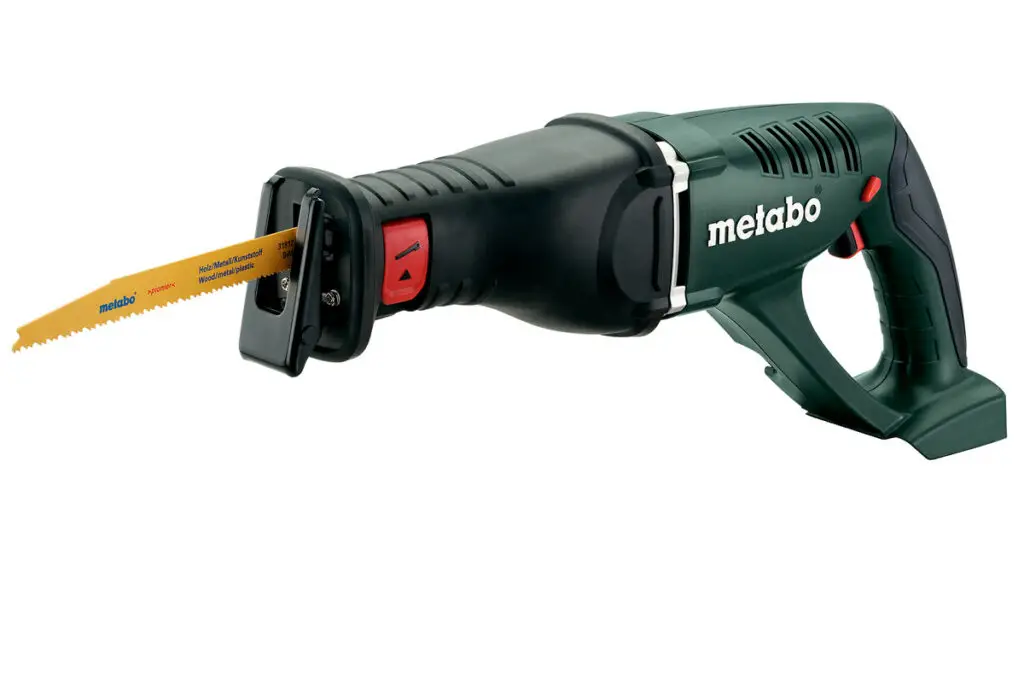
Saber saws are some of the most widely used saws out there. They’re especially known for having a thin type of blade that can be used to cut through almost anything.
They’re known for their portability and the ability to change the blades so that you’re able to create different types of cuts through different kinds of materials.
They’re also quiet and comfortable to use, making it a favorite among woodworkers.
28. Toe-kick Saw

The toe-kick saw is a very specific type of equipment. Unless you use this tool regularly, you will do better if you just rent it from someone who owns it.
It’s a very niche tool that is used to cut under the toe-kick panels of cabinets. This allows you to remove the flooring without ever moving the cabinet.

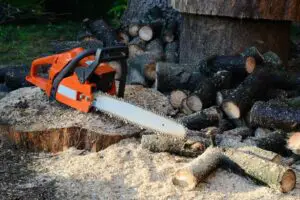

![9 Best Pole Saws of 2023 [Ultimate Guide] 9 Best Pole Saws of 2023 [Ultimate Guide]](https://handykeen.com/wp-content/uploads/2021/03/best-pole-saw-300x200.jpg)

